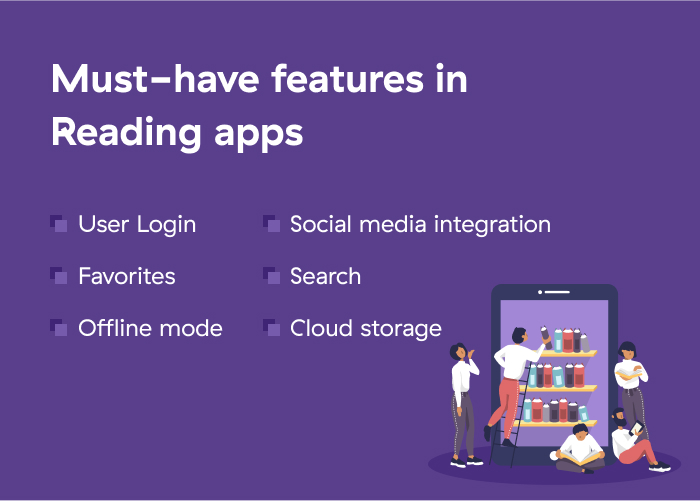Must-have features in reading apps

Below are some of the must-have features of reading apps:
- User Login: The app must allow users to log in from their social media accounts. Furthermore, they can share their experience.
- Favorites: The app should allow users to mark their favorite book for future reading.
- Offline mode: Allowing users to read offline by downloading the book is the best feature that enhances the user experience.
- Search: Furthermore, it should allow the users to search for the books they like to read or want to discover.
- Cloud storage: You can allow cloud storage to users for downloading books that they can read in offline mode.
- Social media integration: With this feature, users can share notes and books with their social friends.
The process of creating reading applications
- Market Research and Conceptualization: Identify the target audience for your reading application. Understand user needs, preferences, and pain points. Research competitors and existing reading applications to identify gaps and opportunities. Define the unique selling points (USPs) of your application.
- Define Features and Functionality: Based on your research, define the features and functionality your reading application will offer.
- Design: Create wireframes and mockups of the user interface (UI) and user experience (UX) of the application. Focus on intuitive navigation, readability, and visual appeal. Design for different devices and screen sizes (responsive design).
- Development: Choose the appropriate technology stack based on your requirements. Develop the front-end and back-end components of the application. Implement features and functionality according to the design and requirements. Integrate APIs for functionalities like book search, authentication, analytics, etc.
- Testing: Perform unit testing to ensure individual components function correctly. Conduct integration testing to verify interactions between different modules. Carry out usability testing to gather feedback from potential users.
- Refinement: Based on user feedback and testing results, refine the application’s features, UI, and UX. Address any bugs, glitches, or performance issues discovered during testing.
- Deployment: Prepare the application for deployment to production servers or app stores. Follow the guidelines of the targeted platforms. Set up analytics and monitoring tools to track user engagement and performance.
- Post-launch Support and Maintenance: Provide ongoing support to address user inquiries and issues. Release updates and patches to improve functionality and address bugs. Monitor user feedback and analytics to identify areas for further improvement.
Cost of making reading apps
The cost of making reading apps can vary significantly depending on various factors:
- Development Team: The size and composition of your development team will impact costs. This includes developers, designers, testers, project managers, and possibly specialists in areas like UI/UX design or backend development.
- Features and Functionality: The more features and functionality you want to include in your reading app, the higher the cost will be. Basic reading apps with standard features will be less expensive than more complex apps with advanced features like social sharing, personalized recommendations, or audiobook integration.
- Design: The complexity of the design, including UI/UX design and customization requirements, can affect costs. Custom designs and animations may require more resources and increase development costs.
- Maintenance and Updates: Post-launch costs include ongoing maintenance, updates, and support to address bugs, add new features, and maintain compatibility with evolving platforms and devices.
Thus, it’s essential to thoroughly plan and prioritize features based on your budget and target audience to optimize costs and ensure a successful reading app development project. Working with an experienced development team or consulting firm can help provide insights into cost estimation and project planning.
Conclusion
Reading apps development costs can vary greatly based on a number of variables, including features, complexity, platform, design, and makeup of the development team. While more complicated applications with more sophisticated capabilities may cost more to design, basic reading apps with common functions may be developed for less money.
To save expenses, features must be thoughtfully planned and prioritized according to your target market and budget. Ensuring a successful development process may be achieved by collaborating with an experienced development team or consulting company, which can offer invaluable insights into project planning and cost prediction.
FAQs
What are some essential features of reading apps?
Which platforms should I target for my reading app?
How can I reduce the cost of developing a reading app?
What are some common challenges in developing reading apps?
How long does it take to develop a reading app?
Ravi Bhojani is the Chief Marketing Officer (CMO) at Alian Software, where he spearheads the company’s marketing strategies and drives its brand presence in the competitive IT services landscape. With over a decade of experience in the technology and marketing sectors, Ravi has consistently demonstrated his ability to blend innovative marketing techniques with deep industry knowledge to deliver outstanding results.